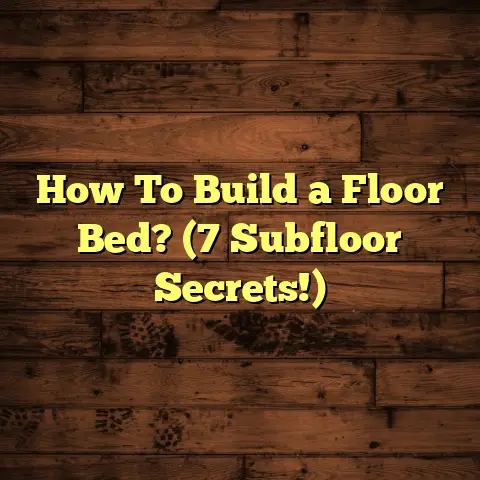Different Color Wood Floors? (3 Style Must-Knows!)
Wood flooring has exploded in popularity, and it’s easy to see why. It brings a warmth and character to a home that few other materials can match. More and more homeowners are getting creative with different colors. We’re seeing everything from bright, airy spaces to rooms with rich, dramatic vibes.
Color is powerful!
It can completely transform a room’s ambiance, making it feel larger, cozier, or more sophisticated. And the best part? Many folks are diving into DIY projects. Thanks to innovations in flooring technology, it’s easier than ever.
We’ve got engineered wood and laminate options that mimic the look of solid wood. These are often more forgiving for the weekend warrior. I’ve seen some amazing transformations, and I’m excited to share some insights.
In this article, I’m going to walk you through three key wood floor styles:
- Light Wood Floors: Think bright, Scandinavian vibes.
- Dark Wood Floors: Imagine rich, elegant sophistication.
- Gray Wood Floors: Picture modern, trendy versatility.
For each style, we’ll dive into the aesthetic, installation, and styling tips.
I’ll give you the inside scoop on how to achieve a flawless look. I’ll also share some of the tricks I’ve learned over the years. So, grab a coffee, settle in, and let’s get started!
Section 1: Light Wood Floors
Light wood floors are a fantastic choice. They are for brightening up any home. I’ve seen them work wonders in small apartments. They can also make a sprawling family home feel even more inviting. Let’s explore what makes them so special.
1.1 Aesthetic Appeal
What’s the first thing that comes to mind when you think of light wood floors? For me, it’s a sense of openness and airiness. Light floors reflect light, making spaces feel larger and brighter. This is especially useful in rooms with limited natural light.
I’ve found that some of the most popular species for light wood floors include:
-
Maple: Known for its clean, uniform grain and light color.
It offers a modern, minimalist look. * Ash: Similar to oak but with a lighter tone and more pronounced grain.
It adds a touch of character without being overwhelming. * Birch: A budget-friendly option with a warm, creamy color.
It brings a cozy feel to any room.
These woods are beautiful in their natural state. They can also be stained or finished to achieve a specific shade of lightness. I often recommend a matte finish to maintain a natural look. It also helps hide scratches and imperfections.
I remember one client who wanted to completely transform their dark, cramped living room. We installed light maple floors. The difference was incredible. The room felt twice as big and so much more inviting. It was like a breath of fresh air!
1.2 Installation Process
Now, let’s talk about installation. There are several methods to choose from. The best one depends on your subfloor, budget, and DIY skills. Here’s a breakdown:
-
Floating: This is often the easiest method for DIYers.
The planks click together and “float” over the subfloor. It doesn’t require nails or glue. Just make sure you use a good quality underlayment for sound insulation. * Glue-Down: This method involves gluing the planks directly to the subfloor.
It provides a very stable, solid feel. It requires more precision and can be messy, so it’s best left to the pros. * Nail-Down: This is the traditional method, ideal for solid hardwood floors.
The planks are nailed to a wooden subfloor. You’ll need a nail gun and some experience to get it right.
Before you start any installation, it’s crucial to prepare the subfloor. Make sure it’s clean, level, and dry. Any imperfections will telegraph through the finished floor. I always recommend using a self-leveling compound to fix any dips or bumps.
Accurate measurements are also key. Calculate the square footage of the room and add at least 10% for waste. It’s better to have too much material than not enough. Trust me, I’ve learned that the hard way!
Here’s a quick tip:
When installing light wood floors, pay attention to the direction of the planks. Running them parallel to the longest wall can make the room feel longer. Installing them diagonally can create a more dynamic look.
1.3 Styling Tips
Okay, so you’ve got your beautiful light wood floors installed. Now, how do you style them? The great thing about light wood is that it’s incredibly versatile. It works well with a variety of design styles.
-
Scandinavian: This style is all about simplicity, functionality, and natural light.
Pair your light wood floors with white walls, minimalist furniture, and pops of muted color. * Minimalist: Similar to Scandinavian, but even more pared down.
Focus on clean lines, neutral tones, and a clutter-free environment. * Coastal: Embrace the beachy vibe with light wood floors, blue and white accents, and natural textures like jute and linen.
When choosing wall colors, consider the undertones of your wood. If your floors have warm undertones, opt for warm whites or soft creams. If they have cool undertones, go for cooler grays or blues.
Furniture-wise, light wood floors provide a great backdrop for a variety of styles. I love the look of light wood floors paired with mid-century modern furniture. The clean lines and natural materials complement each other perfectly.
Don’t be afraid to add pops of color with your accessories. A bright rug, colorful pillows, or a vibrant piece of artwork can add personality to the space. Just remember to keep the overall look balanced and cohesive.
I once helped a client create a stunning coastal-inspired living room. We used light ash floors, white walls, and blue and white striped furniture. The result was a bright, airy, and inviting space that felt like a beach house.
Section 2: Dark Wood Floors
Now, let’s switch gears and explore the world of dark wood floors. Dark floors bring a sense of drama and sophistication to any space. They can create a cozy, intimate atmosphere or a bold, statement-making look.
2.1 Aesthetic Appeal
Dark wood floors exude luxury and elegance. They add warmth and richness to a room. I’ve seen them transform even the most basic spaces into something special.
Popular species for dark wood floors include:
-
Walnut: Known for its rich, dark brown color and beautiful grain patterns.
It adds a touch of luxury to any room. * Mahogany: A classic choice with a reddish-brown hue and a smooth, even texture.
It brings a sense of timeless elegance. * Wenge: A very dark, almost black wood with a distinctive grain.
It creates a dramatic and modern look.
Dark wood floors can be naturally dark or stained to achieve a deeper color. I often recommend a semi-gloss finish to enhance the richness of the wood. It also makes it easier to clean.
One thing to keep in mind is that dark floors can show dust and scratches more easily than light floors. Regular cleaning and maintenance are essential to keep them looking their best. I always advise my clients to use a microfiber mop and a wood floor cleaner specifically designed for dark floors.
I worked on a project where we installed dark walnut floors in a home library. The result was stunning. The dark floors created a warm, inviting atmosphere. It was perfect for curling up with a good book.
2.2 Installation Process
Installing dark wood floors is similar to installing light wood floors. However, there are a few specific considerations to keep in mind.
-
Moisture: Dark woods tend to be more sensitive to moisture than light woods.
Make sure to properly acclimate the wood before installation. This means allowing it to sit in the room for several days to adjust to the temperature and humidity. * Temperature: Extreme temperature fluctuations can also cause dark wood floors to expand and contract.
Maintain a consistent temperature in your home to prevent damage.
As with light wood floors, you can choose from floating, glue-down, or nail-down installation methods. The best choice depends on your subfloor and personal preference.
Here are some essential tools you’ll need:
- Measuring tape: For accurate measurements.
- Saw: To cut the planks to size.
- Tapping block and hammer: To gently tap the planks together.
- Spacers: To maintain consistent gaps around the perimeter of the room.
- Level: To ensure the subfloor is level.
Before you start, make sure to read the manufacturer’s instructions carefully. Each type of flooring has its own specific installation guidelines. Following these guidelines will help ensure a successful installation.
I always recommend starting in a corner of the room and working your way out. This will help you maintain a straight line and avoid any awkward cuts.
2.3 Styling Tips
Styling dark wood floors can be a bit tricky. You don’t want the room to feel too dark or heavy. The key is to balance the dark flooring with lighter furniture and decor.
- Traditional: Pair your dark wood floors with classic furniture, rich fabrics, and warm colors like gold and burgundy.
- Modern: Create a sleek, contemporary look with clean-lined furniture, neutral colors, and pops of bold color.
- Industrial: Embrace the raw, edgy vibe with dark wood floors, exposed brick walls, metal accents, and vintage furniture.
When choosing wall colors, opt for lighter shades like white, cream, or light gray. These colors will help brighten the room and create a sense of balance.
Furniture-wise, consider using lighter woods or upholstered pieces in light colors. This will prevent the room from feeling too dark and heavy.
Rugs are a great way to add warmth and texture to a room with dark wood floors. Choose a rug with a light color and a soft texture to create a cozy and inviting space.
Lighting is also crucial. Make sure you have plenty of natural and artificial light to brighten the room. Consider using lamps, sconces, and overhead lighting to create a well-lit space.
I once helped a client transform their living room with dark mahogany floors. We used light gray walls, white furniture, and pops of blue and yellow. The result was a sophisticated and inviting space that felt both modern and timeless.
Section 3: Gray Wood Floors
Finally, let’s explore the trendy and versatile world of gray wood floors. Gray floors have become increasingly popular in recent years. They offer a modern, sophisticated look that works well with a variety of design styles.
3.1 Aesthetic Appeal
Gray wood floors are the epitome of modern chic. They offer a neutral backdrop that allows your furniture and decor to shine. I’ve seen them used in everything from minimalist apartments to cozy family homes.
Popular gray wood species and finishes include:
-
Oak: A classic choice that can be stained in a variety of gray tones.
It offers a timeless look with a modern twist. * Maple: Known for its smooth, uniform grain.
It takes gray stain beautifully. * Engineered Wood: A budget-friendly option that mimics the look of solid wood.
It comes in a wide range of gray shades and finishes.
Gray wood floors can range from light, almost white grays to dark, charcoal grays. The best choice depends on your personal preference and the overall style of your home.
One of the great things about gray floors is that they can be easily customized to match your decor. You can choose a gray with warm undertones for a cozy, inviting look. You can also opt for a gray with cool undertones for a sleek, modern vibe.
I worked on a project where we installed gray oak floors in a modern loft. The result was stunning. The gray floors created a cool, contemporary backdrop. It was perfect for showcasing the client’s collection of modern art.
3.2 Installation Process
Installing gray wood floors is similar to installing other types of wood floors. However, there are a few specific considerations to keep in mind.
-
Color Consistency: Gray stains can sometimes be tricky to apply evenly.
Make sure to test the stain on a small area before applying it to the entire floor. * Grain Patterns: Pay attention to the grain patterns of the wood.
This will help you create a cohesive and visually appealing look.
As with other types of wood floors, you can choose from floating, glue-down, or nail-down installation methods. The best choice depends on your subfloor and personal preference.
Here are some additional tips for installing gray wood floors:
- Use a high-quality stain: This will help ensure a consistent and durable finish.
- Apply multiple coats of stain: This will help deepen the color and protect the wood.
- Use a polyurethane finish: This will help protect the floor from scratches and wear.
I always recommend hiring a professional installer if you’re not comfortable doing it yourself. Installing wood floors can be tricky. A professional will ensure that the job is done right.
3.3 Styling Tips
Styling gray wood floors can be a lot of fun. They’re incredibly versatile. They can be paired with a wide range of colors and styles.
- Contemporary: Create a sleek, modern look with clean-lined furniture, geometric patterns, and pops of bold color.
- Farmhouse: Embrace the cozy, rustic vibe with vintage furniture, natural textures, and warm colors like cream and beige.
- Eclectic: Mix and match different styles and colors to create a unique and personalized look.
When choosing wall colors, consider using lighter shades like white, cream, or light gray. These colors will help brighten the room. They will create a sense of balance.
Furniture-wise, consider using a mix of wood and upholstered pieces. This will add warmth and texture to the space.
Rugs are a great way to add color and pattern to a room with gray wood floors. Choose a rug with a bold pattern or a vibrant color to create a focal point.
Accessories are also important. Add pops of color with pillows, throws, and artwork. This will help personalize the space and make it your own.
I once helped a client create a stunning eclectic living room with gray wood floors. We used a mix of vintage and modern furniture, colorful rugs, and bold artwork. The result was a unique and personalized space. It reflected the client’s personality and style.
Conclusion
So, there you have it! A deep dive into the world of different color wood floors. We’ve explored the aesthetic appeal, installation process, and styling tips for light, dark, and gray wood floors.
I hope I’ve shown you how easy it can be to install these floors yourself. Choosing the right style for your space is crucial. Consider your personal aesthetic and functional needs. Think about the overall look and feel you want to achieve.
Remember, light wood floors can make spaces feel larger and brighter. Dark wood floors can add warmth and sophistication. Gray wood floors offer a modern and versatile backdrop.
Regardless of your choice, well-installed wood floors can enhance the beauty and value of your home. They’ll also bring you joy for years to come. So, go ahead, dive in, and create the home of your dreams!
If you have any questions or need further advice, don’t hesitate to reach out. Happy flooring!





